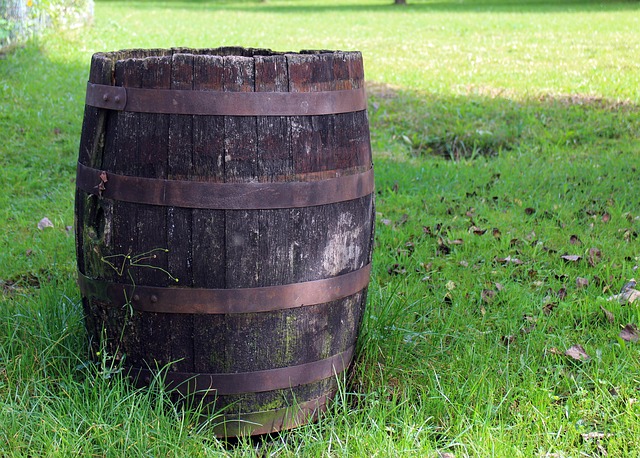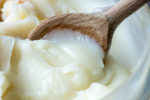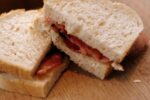
How to Make Your Own Vinegar
Vinegar was an important household item in the 1800s, especially for preserving food. Many people made their own vinegar; often a year’s supply.
INFORMATION BELOW FROM 1800s COOKBOOKS
TO BUY VINEGAR
Much of the vinegar that is offered for sale is excessively and disagreeably sharp; overpowering the taste of every thing with which it is combined. This vinegar is deleterious in its effects and should never be used; it is made entirely of drugs.
Oysters and pickled vegetables have been entirely destroyed or eaten up by it in a few hours, so that nothing was left but a whitish liquid. To avoid all risk from unwholesome vinegar offered for sale, families would do well to make their own. A keg of hard cider kept in a warm kitchen in winter, and exposed to the hot sun in summer, will become excellent vinegar.
Vinegar must have air as well as warmth, and this is especially necessary if you desire to make it in a short space of time. If at any time it seems to be “Dying,” as is usually called, add molasses, sugar, alcohol, or cider–whichever article you are making from.
A cask that has not contained vinegar before should have a quart of boiling hot vinegar poured into it, shaken about frequently till cold, and allowed to stand some hours.
COMMON MOLASSES VINEGAR
Mix together a gallon of West India molasses, and four gallons of lukewarm water. Pour it into a clean five-gallon cask and place it in the chimney-corner standing the cask on end, and leaving the bung* loosely in it. To occasionally give it some additional heat, set the cask in the mouth of the oven on baking-days after the bread is drawn, and let it remain while the oven continues to be warm.
In three months it will be excellent and wholesome vinegar, at a very trifling cost,—only that of the gallon of molasses. When the liquid is sufficiently acid, stop the bung-hole closely, and remove the cask to a cool place. In summer, you may make this vinegar by letting the cask stand three or four months exposed to the hot sun; taking care to cover the bung-hole in damp or rainy weather.
*bung – also called a stopper or cork. A cylindrical or conical object used to seal a container, such as a bottle, tube or barrel.
CIDER VINEGAR
Take six quarts of rye meal, stir and mix it well into a barrel of strong hard cider of the best kind, and then add a gallon of whiskey. Cover the cask, leaving the bung loosely in it. The cask should have iron hoops.
Set it in the part of your yard that is most exposed to the sun and air, and in the course of four weeks (if the weather is warm and dry) you will have good vinegar fit for use. When you draw off a gallon or more, replenish the cask with the same quantity of cider and add about a pint of whiskey. You may thus have vinegar constantly at hand for common purposes.
SUGAR VINEGAR
To every gallon of water, allow a pound of the best brown sugar and a gill* or more of strong yeast. Mix the sugar and water together, and boil and skim it till the scum ceases to rise. Then pour it into a tub and when it cools to lukewarm heat, put into it yeast spread on pieces of toast.
Let it work two days, then put it into an iron-hooped cask and set it in a sunny place for five months, leaving the bung loose, but keeping the bung-hole covered. If the vessel containing the liquor is to be exposed to the sun’s heat, the best time to begin making it is in the month of April. In five months it will be good clear vinegar, and you may bottle it for use.
*gill/jill – a liquid measurement; four ounces in the U.S. and five ounces in the U.K.
HOME-MADE TABLE VINEGAR
Put in an open cask four gallons of warm rain-water, one gallon of common molasses and two quarts of yeast. Cover the top with thin muslin and leave it in the sun, covering it up at night and when it rains. In three or four weeks it will be good vinegar. If cider can be used in place of rain-water, the vinegar will make much sooner; it will not take over a week to make a very sharp vinegar. Excellent for pickling purposes.
VERY STRONG TABLE VINEGAR
Take two gallons of good cider and thoroughly mix it with two pounds of new honey. Pour into your cask or bottle and let it stand from four to six months. You will have vinegar so strong that it cannot be used at table without diluting with water. It is the best ever procured for pickling purposes.
VINEGAR FOR SALADS
Take three ounces each of tarragon, savory, chives, and shallots, and a handful of the tops of mint and balm, all dry and pounded. Put the mixture into a wide-mouthed bottle, with a gallon of the best vinegar. Cork it down close, set it in the sun and in a fortnight,* strain off and squeeze the herbs. Let it stand a day to settle, and strain it through a colander.
*fortnight – a period of two weeks.
WHITE VINEGAR
Put into a cask a mixture composed of five gallons of water, two gallons of whiskey, and a quart of strong yeast, stirring in two pounds of powdered charcoal. Place it where it will ferment properly, leaving the bung loose till the fermentation is over, but covering the hole slightly to keep out the dust and insects. At the end of four months, draw it off and you will have a fine vinegar, as clear and colorless as water.
ANOTHER GOOD VINEGAR
Take five gallons of soft, clear water, two quarts of whisky, two quarts of the best West India molasses, and half a pint of the best fresh yeast. Lay a sheet of white foolscap paper at the bottom of a very clean keg, and pour in the mixture. Place it in the sun the first warm weather at the close of May or beginning of June. In six weeks it will be fit for use. Put in the bung loosely, and do not stop it tight till the fermentation is over. If you make it in winter, keep it in a place where there is a stove or furnace.
=================================================
The Artisanal Vinegar Maker’s Handbook: Crafting Quality Vinegars – Fermenting, Distilling, Infusing
Translated into English for the first time, this guide offers tips on vinegar fermentation distillation and infusion The authors instruct readers on the optimal conditions for creating high-quality vinegar using every imaginable starter material from wines to fruits to herbs as well as recipes for using vinegar in cooking, cleaning, and healthy living.
=================================================
Have You Ever Made Your Own Vinegar? Please Leave a Comment Below.
=================================================




8 thoughts on “How to Make Your Own Vinegar”
I’m making kombucha now and if I let it ferment long enough it turns into vinegar. I may need to try that sometime. I use a lot of white vinegar because I add it to laundry instead of nasty fabric softeners.
I wouldn’t waste kombucha that turned into vinegar on cleaning. I’d try it for a dressing or marinade instead.
This is very interesting information! I would never have consider whiskey in vinegar. It certainly makes me appreciate the bottled vinegar in the grocery store. It is clearly a huge time saver!
There are certainly a lot of food products we take for granted. I find it interesting to read how certain foods were made before they were available commercially.
Interesting! I make many things from scratch and would be kind of cool to make my own vinegar, too, but I probably won’t. I never thought about how it was made before and now I am in the know! Thanks!
I didn’t realize there were so many different bases for vinegar.
Whenever I see recipes like these where something must be left out to ferment, I wonder who was the first person who ate it and said “Hey, that’s pretty good! I think I’ll make some more.” Brave souls! LOL
Maybe they convinced someone they didn’t like to try it first, ha ha.
I enjoy a good vinegar on many foods so will keep this in mind for making my own in the future. Thanks for the recipes!